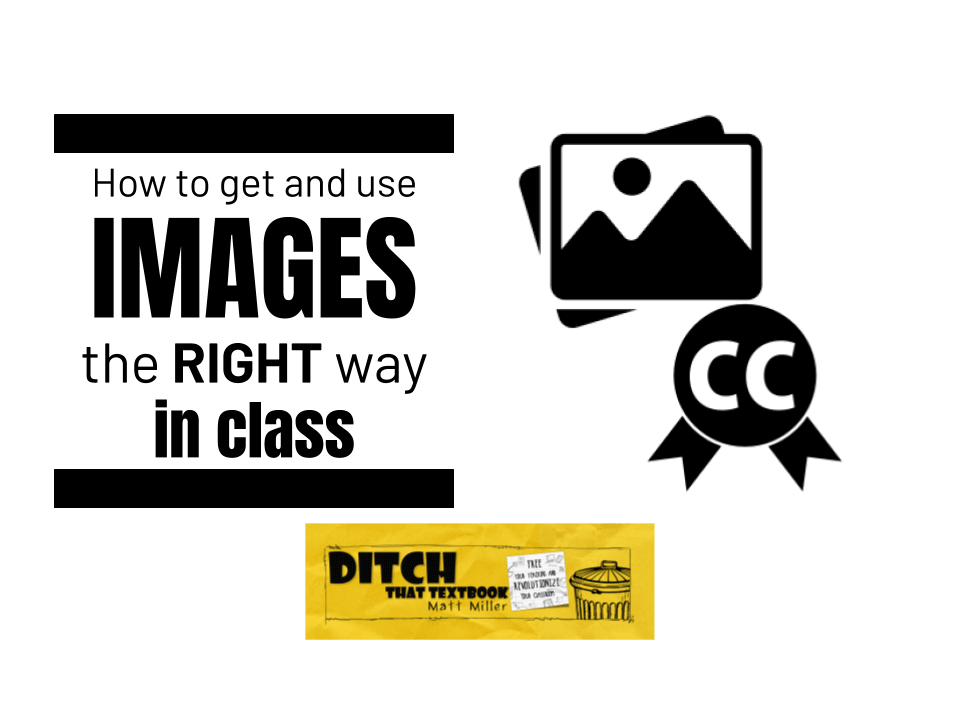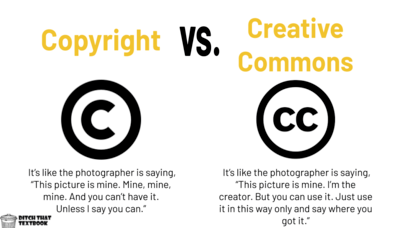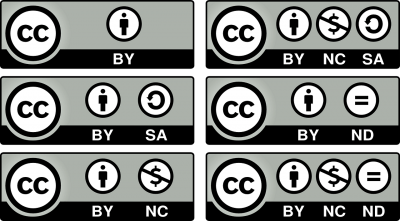
Images can bring presentations, reports and other student work to life. Students should learn to use images responsibly. Here’s what you need to know to help them.
Creating posters has been a staple of so many classrooms of different ages. Usually, it entails gathering some important supplies before starting -- posterboard, glue, markers, etc.
Many teachers will round up old magazines, too, letting students cut and attach images that illustrate their topics.
The digital age has opened classrooms up to a figurative stack of magazines that's virtually unlimited, searchable and easily usable. Plus, you don't have to clean up little bits of cut-up magazine off the floor when you use them.
I'm talking about Creative Commons images. There are lots of them. Generally, they can be used very freely by students in virtually any project or activity.
Copyright vs. Creative Commons
If students are looking for photos and don't have any training on where to find them, where do they often turn? In my experience, it's Google Images.
The problem: a standard Google Images search returns lots of copyright-protected images. Students aren't supposed to use them in their work without receiving permission, and they definitely shouldn't publish them to the web.
The solution: Use Creative Commons photos with proper attribution. (We'll get to that part in a moment.)
Here's a rough analogy I use to explain the difference between copyrighted images and Creative Commons images when I present to teachers:
Copyrighted images (all rights reserved): It's like the photographer is saying, "This picture is mine. Mine, mine, mine. And you can't have it. Unless I say you can."
Creative Commons images: It's like the photographer is saying, "This picture is mine. I'm the creator. But you can use it. Just use it in this way only and say where you got it."
Copyright and Creative Commons licenses aren't just limited to images. They apply to videos, music, content on websites, books and more.

10 Sources of Creative Commons images
Here are some examples of storehouses of tons of images that students can include in their reports, papers, presentations and websites:
1. Creative Commons Search (search.creativecommons.org)
This site gives easy access to several search engines that make Creative Commons works accessible. It's a portal to finding Creative Commons images, video, music and other media. Its image search relies heavily on Google Images searches (set to search only Creative Commons images) or Flickr searches. I won't include Google Images or Flickr below because I always use the Creative Commons Search when I want to access them because it's quick and easy. (Note: Flickr is blocked by some school Internet filters, but Google Images generally is not.)
2. Photos For Class (photosforclass.com)
Giving accurate attribution can to Creative Commons content can be a struggle (something I'll get to momentarily). One way to be sure you're fairly giving credit to the author of Creative Commons images is to use Photos For Class. This site finds images from Flickr's hundreds of thousands of Creative Commons images and automatically embeds the attribution information (i.e. author, website where it was found, link, license, etc.). The photo to the left is an example from Photos For Class. This way, even very young students can use Creative Commons images in a responsible way.
3. Google Apps (drive.google.com)
Google gives users quick access to add a Creative Commons image to a document, slide presentation or drawing in Google Apps. Insert an image (Use "Insert > Image ..." from the menu or the image icon). Then select "Search" from the tabs at the top. This search's default setting is "labeled for commercial reuse with modification" (one of the license types we'll see in a moment). These images insert directly into your Google file without having to leave to go to another website. (See animated GIF at right to watch it in action.)
4. PhotoPin (photopin.com)
PhotoPin was built to give bloggers access to quality Creative Commons photos, but it can be used by anyone. It does access images through Flickr, so, again, if your school's Internet filter blocks Flickr, this one may not work.
5. EveryStockPhoto (everystockphoto.com)
This site pulls photos from a variety of Creative Commons sources.
Creative Commons images aren't the only ones students can use in their work. Photos labeled "public domain" have even fewer restrictions. The intellectual property rights for these images, according to Wikipedia, "have expired, been forfeited or are inapplicable." Public domain photos can be inserted into any work without need for any attribution. Some sources of public domain images:
6. Pixabay (pixabay.com)
This site contains a variety of types of images, ranging from clip art to original photos, that are labeled "public domain." Note: Some of Pixabay's images aren't kid friendly.
7. Pikwizard (pikwizard.com)
This site has over 100,000 free images and videos, with 20,000 of those exclusive to Pikwizard. All of which are free to use without attribution. You can also take each image and edit it on their graphic design tool, Design Wizard!
8. Wikimedia Commons (commons.wikimedia.org)
Wikimedia Commons's well-known cousin, Wikipedia, is a free, open-source encyclopedia of sorts. Wikimedia Commons does the same for different types of media. All of Wikimedia Commons's media is free to use under Creative Commons licenses or public domain, depending on the image.
9. Compfight (compfight.com)
Compfight says on its site that it is "an image search engine tailored to efficiently locate images for blogs, comps, inspiration, and research." It searches images on Flickr and displays licensing information so you can use the images appropriately.
10. Unsplash (Unsplash.com)
Much like Pixabay, unsplash offers a whole searchable gallery of photos that you can use for commercial and noncommercial purposes. Unsplash does not require you to ask permission from or provide credit to the photographer or Unsplash but as they note, it is appreciated when possible.
BONUS! Museums, art galleries and archives
Here's a comprehensive list of collections of art and other images that are in the public domain.
Different licenses and attribution
When people refer to Creative Commons, they're not referring to a single type of license. Rather, they're referring to a spectrum of different licenses that provide different permissions. They're defined by these conditions:
- Attribution: How to give credit to the author (All Creative Commons licenses require attribution)
- Non-commercial: Whether you can profit from your use of the work
- No derivative works: Whether you can change/modify the work
- Share alike: Whether you can share the work under a different license

My favorite explanation of the differences is in this infographic created on Foter: http://foter.com/blog/how-to-attribute-creative-commons-photos/ In fact, I printed it out as a visual reference for my students (completely legal under the Creative Commons license placed on that infographic!).
Armed with beautiful images being used legally, think of what students can create with their own creativity! And they'll be doing it responsibly!
How have you and your students used Creative Commons images and other media? Where do you find your images?
For notifications of new Ditch That Textbook content and helpful links:
Are you looking for quality, meaningful professional learning that both equips and inspires teachers?
Matt provides in-person and virtual keynotes, workshops and breakout sessions that equip, inspire and encourage teachers to create change in their classrooms. Teachers leave with loads of resources. They participate. They laugh. They see tech use and teaching in a new light. Click the link below to contact us and learn how you can bring Matt to your school or district!
Is Matt presenting near you soon? Check out his upcoming live events!



Thank you so much this is a very helpful tool and also a protective and productive
way for both the school and student.
I never knew that, thank you for this great information
Hello: I am an older lady in Lonestar College North-Harris Campus, thank you so much for letting us know where to find Pictures at besides google, I am also glad you helped
me learn how to Copyright the poems and songs I have written over the years, I have poems, I started writing poems and songs when I was 13 or 14 yrs. old
Great very informative
My HS Art students use Bing Images. The search results can be filtered to the license that best fits As athe needs at the moment, depending on where and how the images will be used. Such an important topic.
[…] access to millions of images from its museums, libraries, and archives. Plus, there are LOTS of other image repositories students can search and use for free. No more ripping off copyrighted watermarked images from Google […]
[…] a good explanation of image attribution, check out this article called “How to get and use free images the RIGHT way in class” by Matt […]
[…] How to Get and Use Free Images the Right Way in Class – Confused by copyright law? Join the club. It’s tricky to teach students about how to use materials online when it’s so easy to download anything. This practical guide helps spell it out. […]
Karen is right! Unsplash is great. They even have a spot where the highlight the work of people that have used their images!
[…] Sourced through Scoop.it from: ditchthattextbook.com […]
At https://unsplash.com/ they don’t even require attribution! It’s a great site and now has a search feature.
[…] Sourced through Scoop.it from: ditchthattextbook.com […]
[…] How to get and use free images the RIGHT way in class | Ditch That Textbook @jmattmiller ditchthattextbook.com/2015/09/04/how… […]
Such a great piece to help develop good digital citizens!!! Maybe if we can dramatically improve attribution of unaltered photos, the number included in Creative Commons will go up significantly.
A suggestion: It would be equally valuable to consider personal options students have with respect to THEIR photos and sketches…